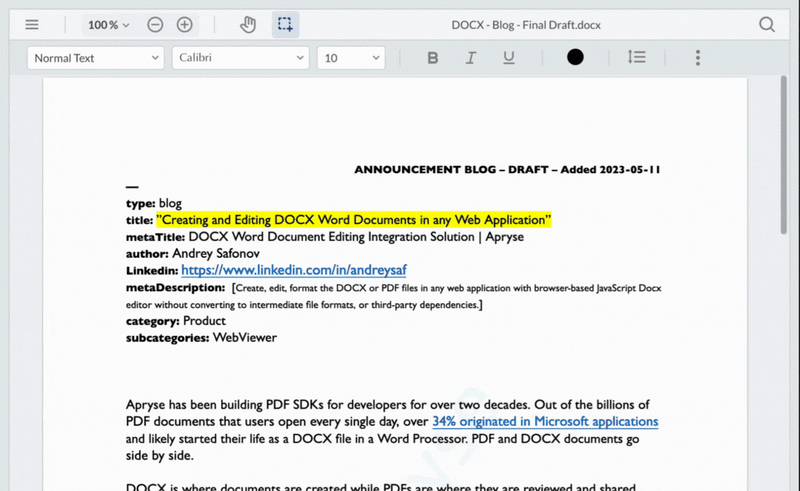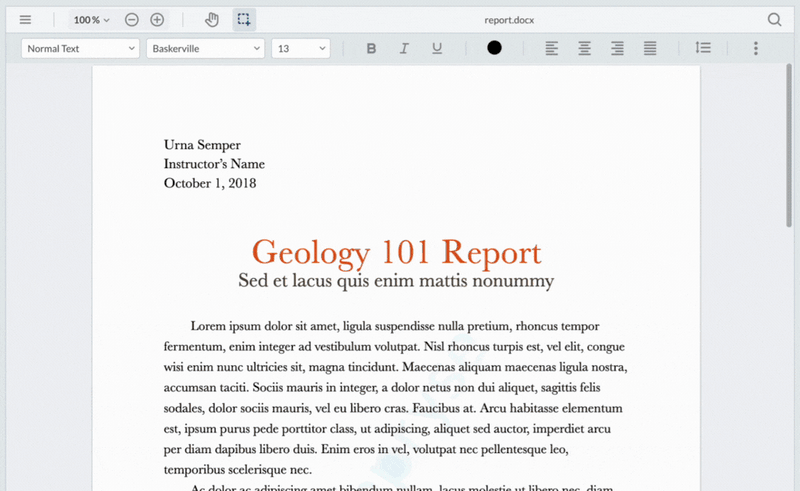Create and Edit Word DOCX Documents in Any Web Application
By Andrey Safonov | 2023 May 29

4 min
Tags
docx editor
webviewer
webviewer
edit
docx
web
react
angular
vue
nuxt.js
next.js
We are thrilled to announce a JavaScript DOCX Editor that allows creating new or editing existing native DOCX documents in any web application, without conversion to intermediate formats, server-side processing, or embedding third-party dependencies.

Native DOCX Editing is now possible in any web application!
Apryse has been building PDF SDKs for developers for over two decades. Out of the billions of PDF documents that users open every single day, over 34% originated in Microsoft applications and likely started their life as a DOCX file in a Word Processor. PDF and DOCX documents go side by side.
DOCX is where documents are created while PDFs are where they are reviewed and shared. Over the past few years, Apryse has reverse-engineered Microsoft’s closed DOCX specification into a professional web editor SDK that has been successfully tested with over 50,000 DOCX documents. Combined with the industry-leading PDF-to-Office conversion technology from partner Solid Documents (acquired by Apryse in 2021), Apryse now proudly offers the best of both DOCX and PDF in a complete end-to-end solution with creation, viewing, editing, tooling, and seamless connection of workflows between the two formats: Because the primary thing a user cares about is to get their work done as efficiently as possible, no matter whether the file is displayed as DOCX or PDF.
Want to know more? Read on to learn all about the new DOCX Editor and how to add it to your web application - or try the live demo right now in the DOCX Editor showcase.
This first release introduces the following DOCX capabilities:
- Create new DOCX documents.
- Open and edit existing DOCX documents.
- Change text styling (bold, italics, underline).
- Change fonts, font size, and set headings.
- Align, justify, and control line spacing.
- Insert bullets or numbered lists.
The DOCX Editor can be easily embedded into any web application built in JS with React, Angular, Vue, Nuxt.js, and Next.js frameworks – and it’s also readily available to add more frameworks, or embed with just a few clicks in your low-code building tools (Salesforce, Appian, or Mendix, and more).
Learn more about Apryse's PDF and DOCX editor functionality.
Why to Embed DOCX Editing Into Web Apps

Change fonts, styling, colors, and more - just like in Microsoft Word.
Implementing DOCX editing workflows adds significant value to the application and elevates the end-user experience by consolidating workflows across multiple on- and offline applications from different vendors into one single web application. Apryse’s JavaScript DOCX Editor is the only SDK that embeds native DOCX editing right within your web application.
The Unaddressed Problem With How We Currently Edit DOCX
Microsoft Office and Google Docs are the two alternatives most of us have top of mind to work with DOCX documents.
From the viewpoint of product leaders and developers, this is a problem:
These applications require files to be downloaded or hosted online (e.g. on SharePoint, or Google Drive), which adds security risks and overhead. It also does not offer any document control for sensitive documents, allowing them to linger in the downloads folder and be subject to leaks. The workflows happening outside of the document workflow in the web application represent a gap in control over the user experience, and users may drop off and perhaps not return to your application.
When users eventually find their way back to the web application to continue their work and upload the edited DOCX, the succession of file movements by the end-user often results in regular versioning issues. Product and business leaders understand that interrupting workflows with a mix of offline and cloud-hosted applications is ultimately not helping user retention and product usage of any web application that involves document workflows.

What you see is what you get - Edit & Save to DOCX directly without resorting to intermediate formats
Eliminate Security Loopholes from Server-Side Dependencies
Client-side editing of native DOCX solidifies the security and scalability of your document infrastructure. When apps rely on intermediate formats or HTML, the export for subsequent use as a document requires it to be converted server-side to DOCX. This conversion typically uses a custom-made translation layer, open-source libraries like LibreOffice, or an MS Office instance on the server to ensure compliance.
While the translation between formats can also lead to information loss, the critical bottleneck of this alternative are limited server-backed processes that make DOCX editing a cost center for infrastructure costs and further compromise security.
Why Native DOCX Editing Matters to Users
Developers know that the reason why most DOCX editing still happens within Microsoft Word is that, unlike PDF, the DOCX format is still locked and hard for outside developers to truly support with native editing. Cloud-hosted document editors such as Google Docs revert to their proprietary format before then letting you download and save their files by converting to DOCX on demand.
This problematic workaround holds for today’s landscape of embeddable “DOCX editors” overall:
These tools rely on their proprietary intermediate format or HTML, making it look like a DOCX file. The problem of this process is easily revealed when the intermediate format is saved to DOCX, and no longer looks the same to the next user who opens it in Microsoft Word. This inconsistent quality then leads to wasted time because of duplicate reviews and additional work to correct formatting, styling, and other differences.
True WYSIWYG Editing
Apryse DOCX Editor reverse-engineers the DOCX format to let users edit a native DOCX file in the browser, eliminating by design any formatting inconsistencies that would occur by saving as DOCX after the fact like other DOCX editing alternatives.
By incorporating Word workflows in your web application, you provide a true
What You See Is What You Get (WYSIWYG) editing experience, maintaining the document's original formatting and quality, which not only delights your end-users but also enhances productivity and satisfaction with your app.

Even Add Bullet Points and Numbered Lists on the Fly
Users can decrease or even eliminate entirely the need for external tools to reduce versioning issues and security concerns for their organization while focusing their productivity by consolidating their workflows to a single web application.
This approach is strongly aligned with the security-by-design that our customers value, as DOCX Editor - just like WebViewer - does not require server-side conversions that can introduce compliance risks. With secure, intuitive, and true WYSIWYG editing at their disposal, DOCX can be embedded in any web application to streamline Word workflows into the WebViewer experience, driving productivity and user satisfaction.
What is Next?
The Microsoft Word desktop application has thousands of features, but the most used key functionalities are those that help us get our jobs done. Apryse DOCX Editor comes with the initial set of key DOCX functionalities to give users the essential tools to create, edit, and style Word documents.
More features will be added rapidly and consistently with every new periodic release, each one of them allowing you to power more and more DOCX workflows in your app.
Learn how you can create and edit tables in DOCX.
Demo & Documentation
Start experiencing Apryse DOCX Editor today with our interactive demo, or get started easily through our documentation. Any questions or feedback? Just reach out to us directly.
Tags
docx editor
webviewer
webviewer
edit
docx
web
react
angular
vue
nuxt.js
next.js
Related Products
SDKs for Document Viewing, Annotation, Conversion and Generation
Share this post




